三维洛伦兹简单量子引力中的尖刺和棘
IF 3.6
3区 物理与天体物理
Q2 ASTRONOMY & ASTROPHYSICS
引用次数: 0
摘要
量子引力的简单方法,如量子雷格微积分和自旋泡沫,包括在保持边界边缘长度较小的情况下,体积边缘可以变得任意大的配置。这种结构在欧几里得量子Regge微积分中提出了重大挑战,因为它们导致配分函数和长度期望值的无限大。本文在三维洛伦兹量子Regge微积分中研究了这种构型,发现配分函数和长度期望值仍然是有限的。这表明洛伦兹方法可以避免欧几里得方法的一个关键问题。我们还发现,对于体积边可以变得非常大的构型空间,比欧几里得情况丰富得多。特别地,它包括不规则光锥结构的构型,这导致Regge作用中的虚项和沿洛伦兹路径积分轮廓的分支切割。因此,要有意义地定义洛伦兹雷格路径积分,就需要澄清如何处理这样的构型。本文章由计算机程序翻译,如有差异,请以英文原文为准。
Spikes and spines in 3D Lorentzian simplicial quantum gravity
Simplicial approaches to quantum gravity such as Quantum Regge Calculus and Spin Foams include configurations where bulk edges can become arbitrarily large while keeping the lengths of the boundary edges small. Such configurations pose significant challenges in Euclidean Quantum Regge Calculus, as they lead to infinities for the partition function and length expectation values. Here we investigate such configurations in three-dimensional Lorentzian Quantum Regge Calculus, and find that the partition function and length expectation values remain finite. This shows that the Lorentzian approach can avoid a key issue of the Euclidean approach. We also find that the space of configurations, for which bulk edges can become very large, is much richer than in the Euclidean case. In particular, it includes configurations with irregular light-cone structures, which lead to imaginary terms in the Regge action and branch cuts along the Lorentzian path integral contour. Hence, to meaningfully define the Lorentzian Regge path integral, one needs to clarify how such configurations should be handled.
求助全文
通过发布文献求助,成功后即可免费获取论文全文。
去求助
来源期刊

Classical and Quantum Gravity
物理-天文与天体物理
CiteScore
7.00
自引率
8.60%
发文量
301
审稿时长
2-4 weeks
期刊介绍:
Classical and Quantum Gravity is an established journal for physicists, mathematicians and cosmologists in the fields of gravitation and the theory of spacetime. The journal is now the acknowledged world leader in classical relativity and all areas of quantum gravity.
 求助内容:
求助内容: 应助结果提醒方式:
应助结果提醒方式:


